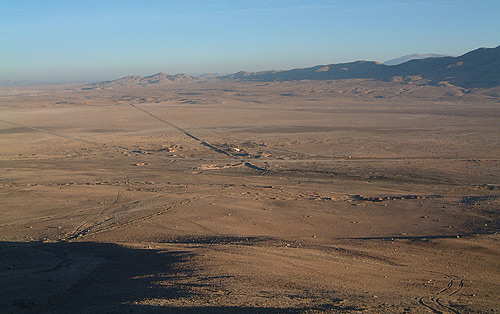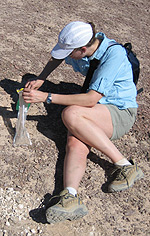Berkeleyan
 Located at an isolated crossroads in Chile's Atacama Desert, the Yunguy field station (above) is an ideal spot to test instruments destined for Mars. (Allison Skelley photo) |
Life-detection instrument passes key test on road to Mars
At the ends of the earth, Berkeley researchers test for left-handed amino acids and other clear signs of life
![]()
| 03 August 2005
The dry, dusty, treeless expanse of Chile's Atacama Desert is the most lifeless spot on the face of the earth, and that's why Alison Skelley and Richard Mathies joined a team of NASA scientists there earlier this month.
The Berkeley scientists knew that if the Mars Organic Analyzer (MOA) they'd built could detect life in that crusty, arid land, it would have a good chance someday of detecting life on the planet Mars.
 Berkeley graduate student Alison Skelley, seen taking samples at the Rock Garden site in the Atacama, helped develop equipment that may someday land on the red planet to search for signs of life that might have once existed there. (Richard Mathies photo) |
"We feel that measuring homochirality — a prevalence of one type of handedness over another — would be absolute proof of life," said Mathies, professor of chemistry at Berkeley and Skelley's research adviser. "We've shown on Earth, in the most Mars-like environment available, that this instrument is a thousand times better at detecting biomarkers than any instrument put on Mars before."
The instrument has been chosen to fly aboard the European Space Agency's ExoMars mission, now scheduled to launch in 2011. The MOA will be integrated with the Mars Organic Detector, which is being assembled by scientists directed by Frank Grunthaner at the Jet Propulsion Laboratory (JPL) in Pasadena, together with Jeff Bada's group at UC San Diego's Scripps Institution of Oceanography.
Skelley, a graduate student who has been working on amino-acid detection with Mathies for five years and on the portable MOA analyzer for the past two years, is hoping to remain with the project as it goes through miniaturization and improvements at JPL over the next seven years in preparation for its long-range mission. In fact, she and Mathies hope she's the one looking at MOA data when it's finally radioed back from the red planet.
"When I first started this project, I had seen photos of the Martian surface and possible signs of water, but the existence of liquid water was speculative, and people thought I was crazy to be working on an experiment to detect life on Mars," Skelley said. "I feel vindicated now, thanks to the work of NASA and others that shows there used to be running liquid water on the surface of Mars."
Mathies said that his experiment is the only one proposed for ExoMars or the United States' own Mars mission — NASA's roving, robotic Mars Science Laboratory mission — that could unambiguously find signs of life. The experiment employs state-of-the-art capillary electrophoresis arrays, novel microvalve systems, and portable instrument designs pioneered in Mathies' lab to look for homochirality in amino acids. These microarrays with microfluidic channels are 100 to 1,000 times more sensitive for amino-acid detection than the original life-detection instrument flown on the Viking landers in the 1970s.
The Atacama Desert was selected by NASA scientists as one of the key spots to test instruments destined for Mars, primarily because of its oxidizing, acidic soil, which is similar to the rusty-red oxidized iron surface of Mars. Skelley and colleagues Pascale Ehrenfreund, professor of astrochemistry at Leiden University in The Netherlands, and JPL scientist Frank Grunthaner visited the desert last year, but were not able to test the complete, integrated analyzer.
This year, Skelley, Mathies and other team members carried the complete analyzers in three large cases to Chile by plane — in itself a test of the ruggedness of the equipment — and trucked them to the barren Yunguy field station, essentially a ramshackle building at a deserted crossroads. With a noisy Honda generator providing power, they set up their experiments and, with six other colleagues, tested the integrated subcritical water extractor together with the MOA on samples from popular test sites such as the "Rock Garden" and the "Soil Pit."
One thing they learned is that with low environmental levels of organic compounds, as is likely to be the case on Mars, the microfluidic channels in the capillary disks don't get clogged as readily as they do when used to test samples in Berkeley, with the city's high bioorganic levels. That means they'll need fewer channels on the instrument that travels to Mars, and the scanner used to read out the data needn't be as elaborate. This translates into a cheaper and easier way to build instruments, but more importantly, an instrument that is smaller and uses less power.
With the success of this crucial field test, Skelley and Mathies are eager to get to work on a prototype of their instrument that would fit in the allowed space within the ExoMars spacecraft.
"The connection between water and life has been made very strongly, and we think there is a good chance there is or was some life form on Mars," Mathies said. "Thanks to Alison's work, we're now in the right position at the right time to do the right experiment to find life on Mars."

